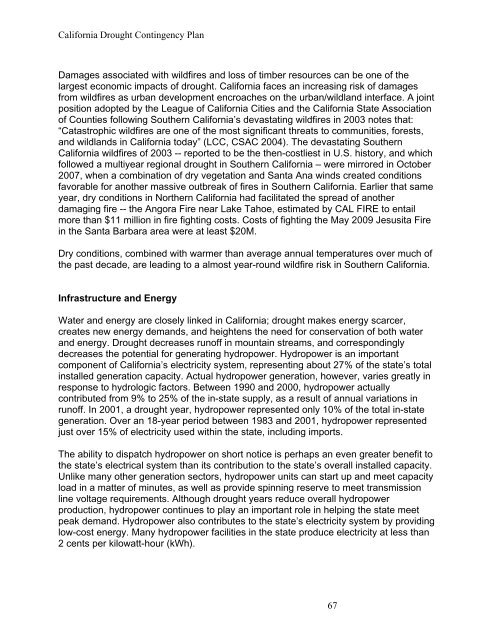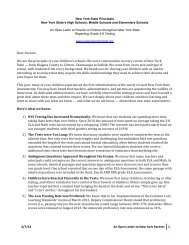Final_CA_Drought_Contingency_Plan-11-18-2010a
Final_CA_Drought_Contingency_Plan-11-18-2010a
Final_CA_Drought_Contingency_Plan-11-18-2010a
Create successful ePaper yourself
Turn your PDF publications into a flip-book with our unique Google optimized e-Paper software.
California <strong>Drought</strong> <strong>Contingency</strong> <strong>Plan</strong>Damages associated with wildfires and loss of timber resources can be one of thelargest economic impacts of drought. California faces an increasing risk of damagesfrom wildfires as urban development encroaches on the urban/wildland interface. A jointposition adopted by the League of California Cities and the California State Associationof Counties following Southern California’s devastating wildfires in 2003 notes that:“Catastrophic wildfires are one of the most significant threats to communities, forests,and wildlands in California today” (LCC, CSAC 2004). The devastating SouthernCalifornia wildfires of 2003 -- reported to be the then-costliest in U.S. history, and whichfollowed a multiyear regional drought in Southern California – were mirrored in October2007, when a combination of dry vegetation and Santa Ana winds created conditionsfavorable for another massive outbreak of fires in Southern California. Earlier that sameyear, dry conditions in Northern California had facilitated the spread of anotherdamaging fire -- the Angora Fire near Lake Tahoe, estimated by <strong>CA</strong>L FIRE to entailmore than $<strong>11</strong> million in fire fighting costs. Costs of fighting the May 2009 Jesusita Firein the Santa Barbara area were at least $20M.Dry conditions, combined with warmer than average annual temperatures over much ofthe past decade, are leading to a almost year-round wildfire risk in Southern California.Infrastructure and EnergyWater and energy are closely linked in California; drought makes energy scarcer,creates new energy demands, and heightens the need for conservation of both waterand energy. <strong>Drought</strong> decreases runoff in mountain streams, and correspondinglydecreases the potential for generating hydropower. Hydropower is an importantcomponent of California’s electricity system, representing about 27% of the state’s totalinstalled generation capacity. Actual hydropower generation, however, varies greatly inresponse to hydrologic factors. Between 1990 and 2000, hydropower actuallycontributed from 9% to 25% of the in-state supply, as a result of annual variations inrunoff. In 2001, a drought year, hydropower represented only 10% of the total in-stategeneration. Over an <strong>18</strong>-year period between 1983 and 2001, hydropower representedjust over 15% of electricity used within the state, including imports.The ability to dispatch hydropower on short notice is perhaps an even greater benefit tothe state’s electrical system than its contribution to the state’s overall installed capacity.Unlike many other generation sectors, hydropower units can start up and meet capacityload in a matter of minutes, as well as provide spinning reserve to meet transmissionline voltage requirements. Although drought years reduce overall hydropowerproduction, hydropower continues to play an important role in helping the state meetpeak demand. Hydropower also contributes to the state’s electricity system by providinglow-cost energy. Many hydropower facilities in the state produce electricity at less than2 cents per kilowatt-hour (kWh).67






